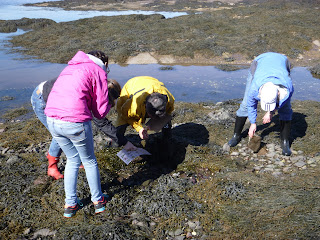As part of this celebration the Huntsman Education Department invited students from local high schools to participate in hands-on marine biology activities aboard the research vessel, on the shore and in the lab.
Join us on our Science Odyssey!
On the hunt for the invasive green crab.
Data is gathered on the size and gender of the collected crabs.
Crabs are marked.
We even found a female green crab carrying eggs.
Studying the anatomy of a live sea urchin (madreporite, tube feet, pedicellariae).
One of the seastars obliged and showed us its stomach.
While aboard the research vessel we conducted benthic drags to see the diversity of animals that live at the bottom of the bay.
We found a scallop!
waved whelk eggs
rock crab
sea urchins of many sizes
sea cucumber
blood star with a mutation
sponge
brittle star
Plankton was collected from the surface to study in the lab.
Students used equipment such as a salinometer and secchi disk (pictured) to gain a better understanding of the marine environment.
Using the microscopes to study the diversity of the collected plankton.
Some of the zooplankton collected: polychaete (worm), medusa and copepods.
Students received a certificate.
Students also received a Huntsman reusable water bottle.

















































